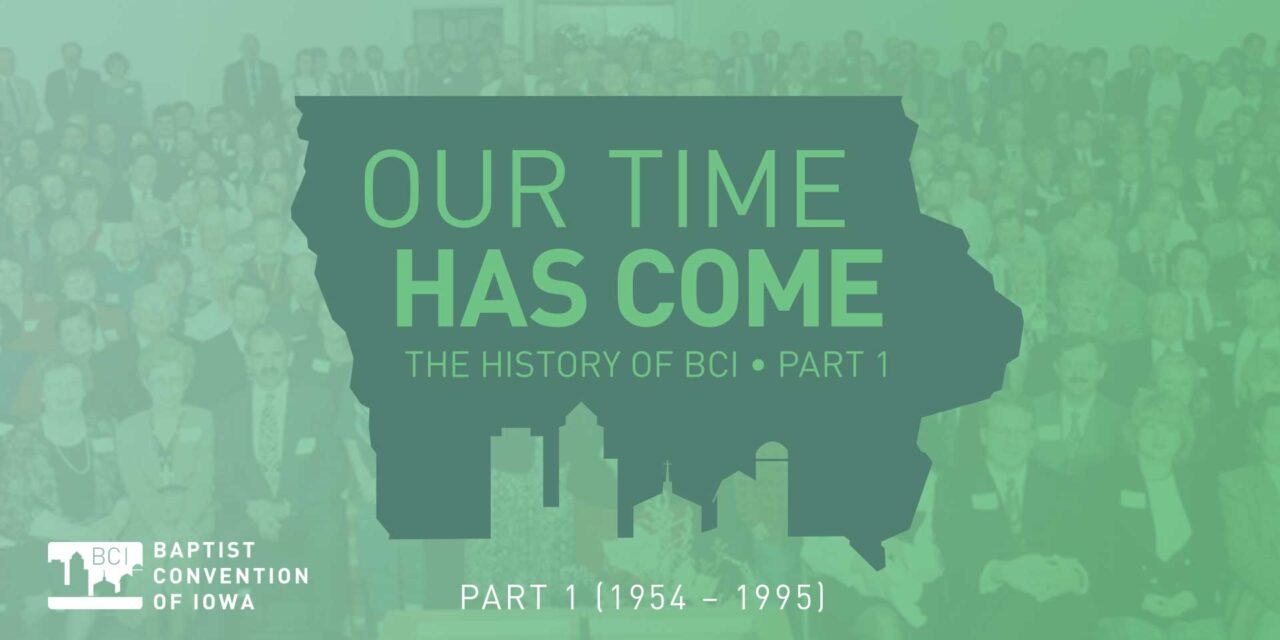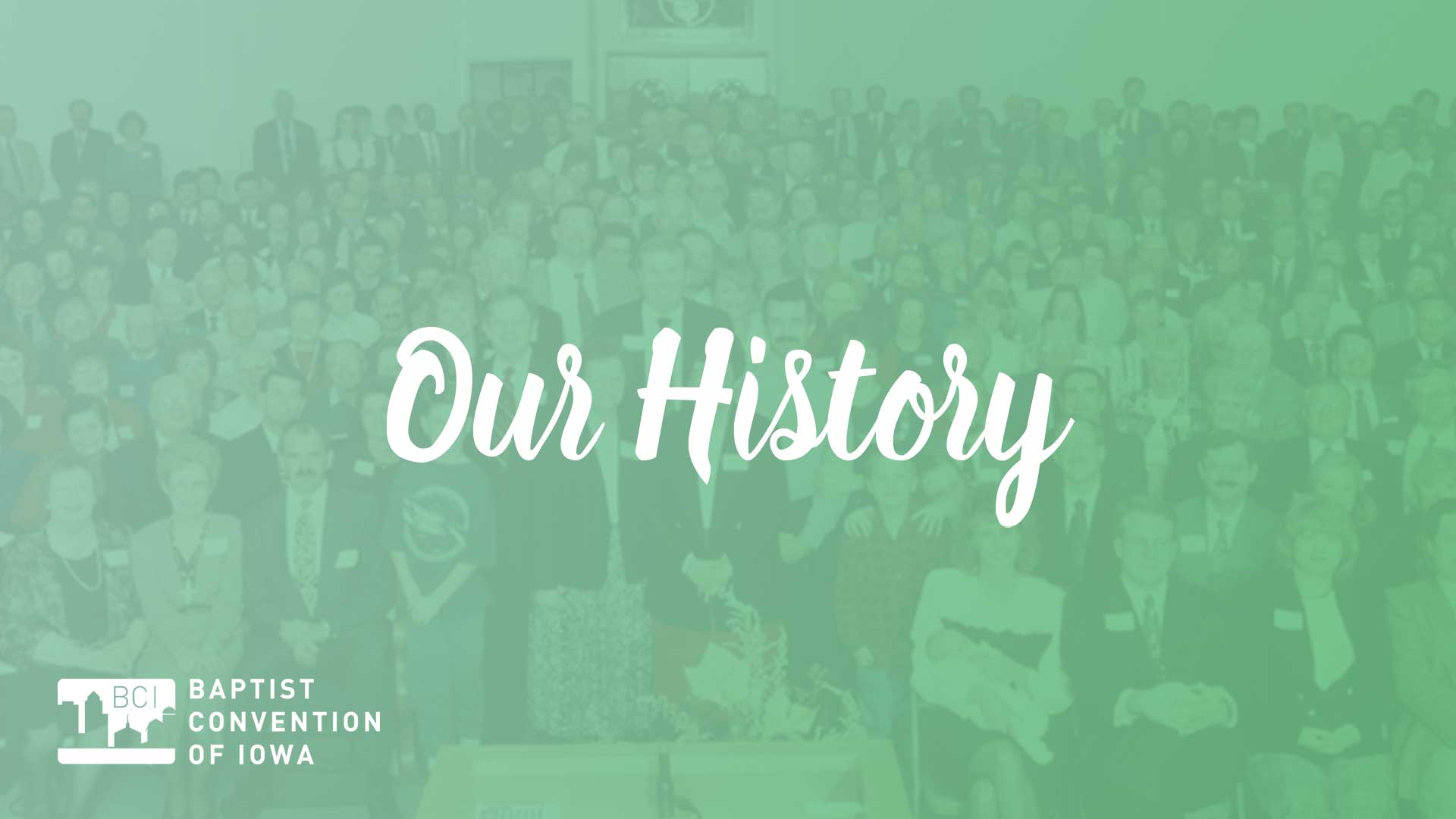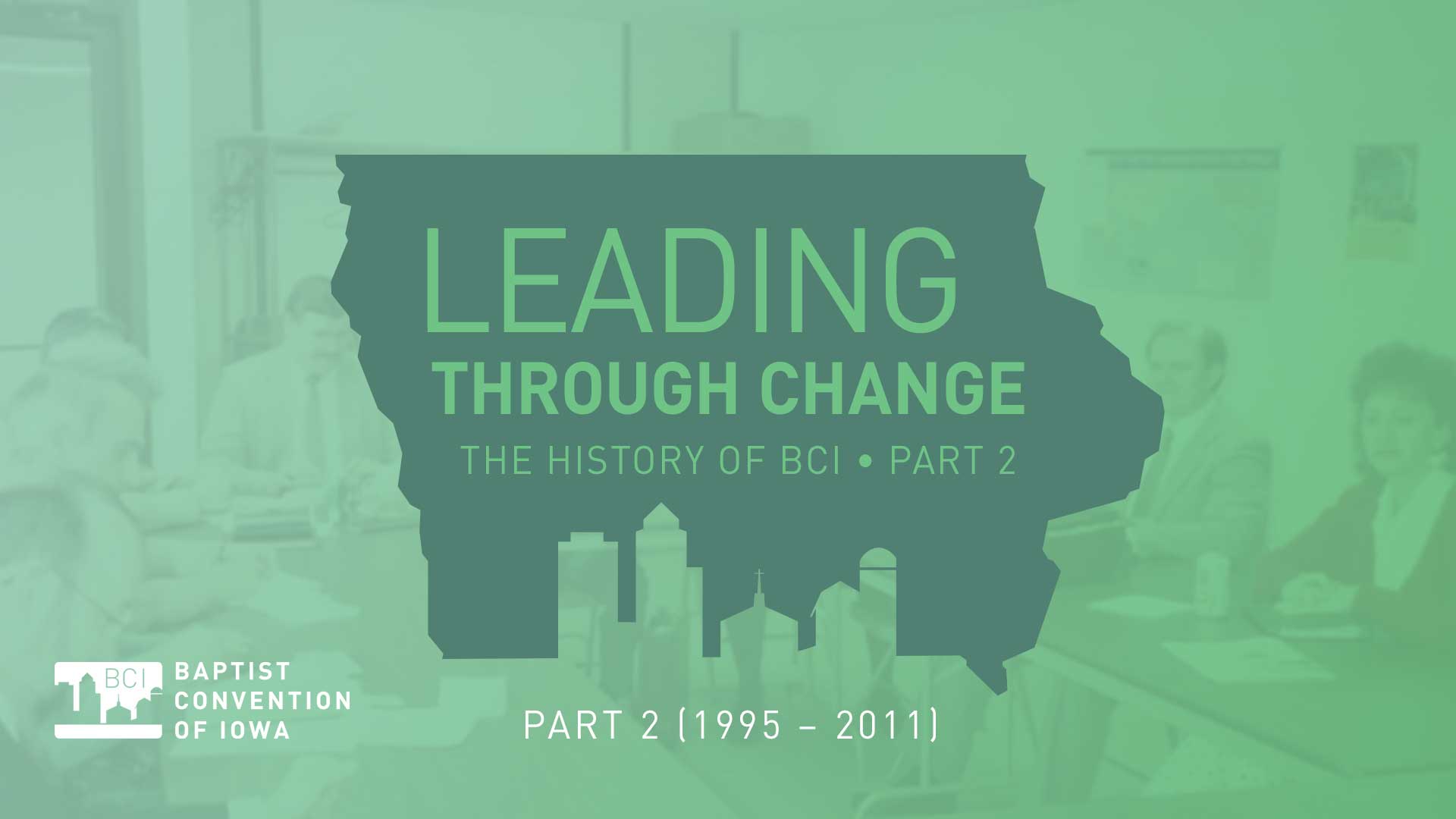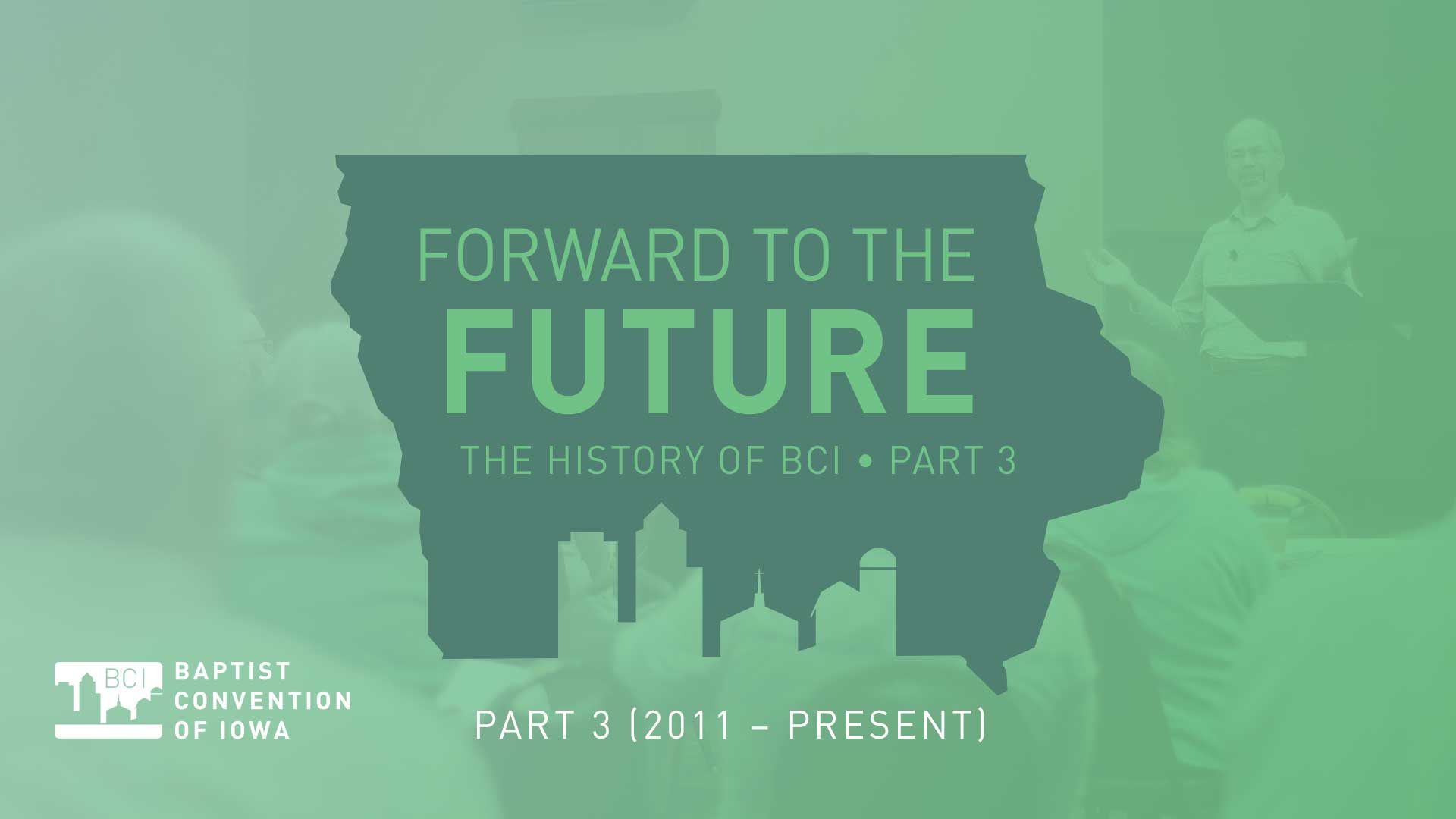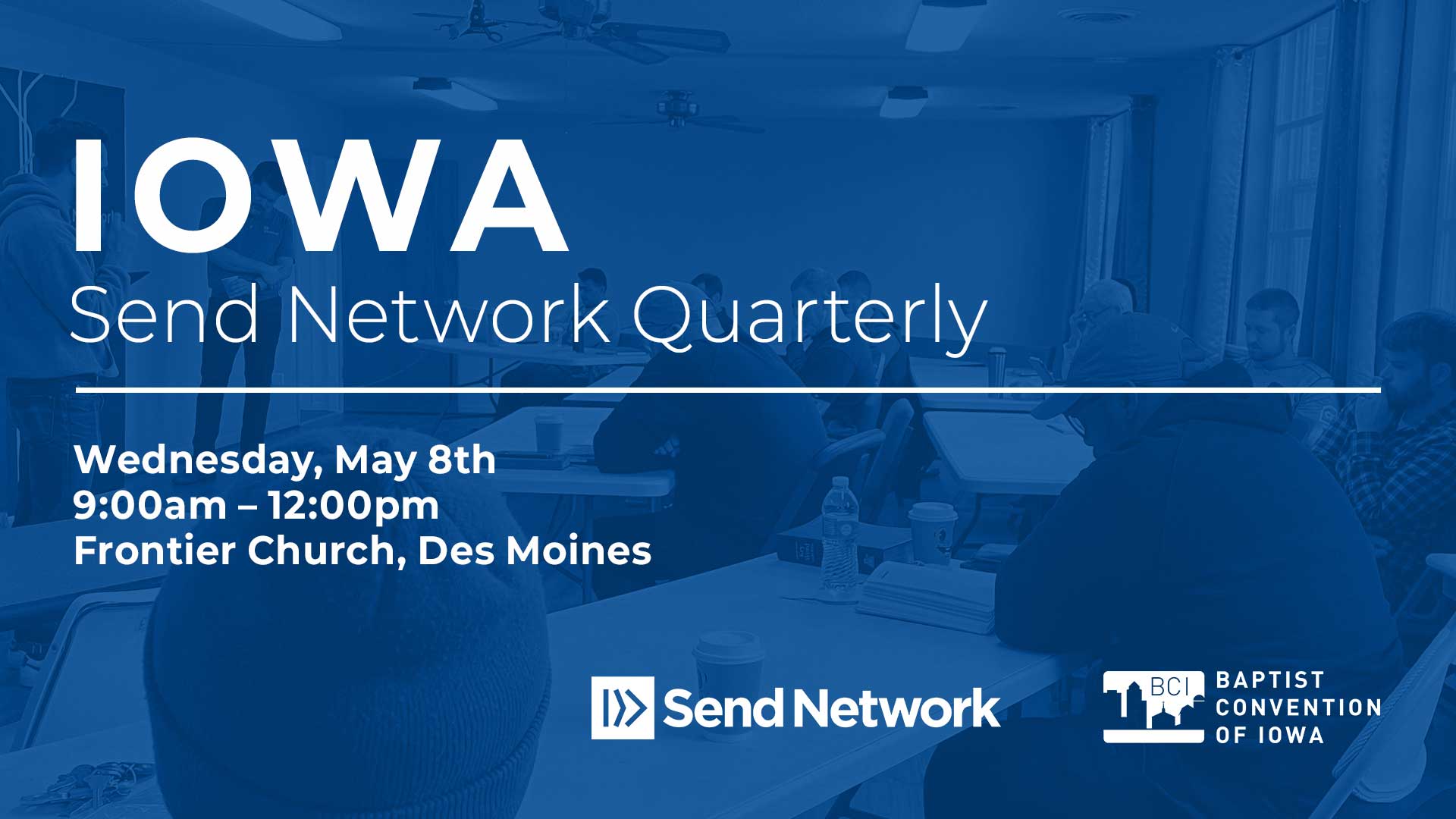This is part 1 of a 3-part series of articles on the history of the Baptist Convention of Iowa.
In this first installment, we’ll remember the legacy of partnership and faithful ministry that characterized each phase of the establishment of the convention. One thing that shines through is how much the local churches worked together to form ministry partnerships fueled by faith and cooperation.
In 2020, the Baptist Convention of Iowa (BCI) celebrated 25 years of ministry as a convention in Iowa. However, that ministry was built on many more years of history that goes back well before the founding of BCI.
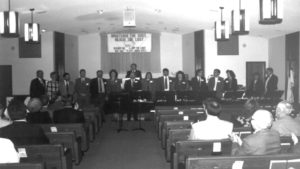 More than 25 years of ministry
More than 25 years of ministry
Before becoming a convention, the first SBC churches in Iowa were organized as the “Iowa Association” of the Missouri Baptist Convention. After a season of growth and development, the organization eventually became the “Iowa Southern Baptist Fellowship” and was still under the leadership of the Missouri Convention. Eventually, when the time was deemed right, the Iowa Fellowship was “constituted” as convention in 1995. “Our Time Has Come” was the theme of the constituting event and leaders from more than 90 churches and “missions” (new potential churches) were part of the process.
“The ministry of BCI is built on history that goes way beyond the last 25 years,” said Ed Gregory, BCI Pastor Church Support Staff for Eastern Iowa. Before serving on staff at BCI, Ed served as pastor at Immanuel Baptist in Cedar Rapids between 1982-1999. Ed was involved with the organization even prior to the establishment of the convention and has served under all three of the full time executive directors, starting with Dr. Wyndell Jones.
 Missionary Church Planting in Iowa – Missouri Association
Missionary Church Planting in Iowa – Missouri Association
The history of Southern Baptist work in Iowa goes back to the mid 1800s. There were a couple churches in Iowa that participated in the Wakonda Association in Northern Missouri. Ed Gregory explains, “These remote church plants were seen as the outflow of vision that the Missouri Baptist Convention had to expand the Kingdom of God in the Midwest. They always respected the differences between the states but they didn’t see the state border as a barrier to gospel ministry.” When it was determined that there was a need for more work in Iowa, they began to intentionally send pastors and missionaries. The first SBC church was established in Anamosa, Iowa in 1954. After the success of establishing the first few churches, the North Grand River Association in North Missouri assigned their mission director one weekend per month to plant new churches in Iowa.
 Iowa Southern Baptist Association
Iowa Southern Baptist Association
In 1960, Avery Wooderson became the Superintendent of Mission to serve exclusively in Iowa. Many of the early SBC churches were started during this period. By 1965, there were a significant number of thriving churches in the region and the decision was made to establish the “Iowa Southern Baptist Association.” The Iowa Association was formed with 25 churches and over 2,000 members by that time and the Association continued until 1972.
Pastor Jerry McFerron remembers those years of the Iowa Association. Pastor Jerry served overseas with the IMB for many years before serving as pastor at Calvary Baptist Church in Leon until his retirement in May, 2021. Pastor McFerron is also the son of Pastor Claude McFerron, one of the most influential pastors in the convention for many decades. “My dad intended to go overseas but God called him to pastor in Waterloo. So our family moved to Iowa from Missouri in the early 1960s.” Pastor Claude became the pastor at Immanuel Baptist Church in Waterloo, before planting Calvary Baptist in Indianola, and then Calvary Baptist in Marshalltown. Pastor Jerry remembers going to summer camp at the Eldora Quaker Camp with all the youth from around the Association. “That was a big spiritual marker for me as I heard many gospel testimonies. But the summer camp was also a big highlight for the pastors too. They were all so far apart and they didn’t have the same opportunities to connect that we have now with the internet. Every church leader really looked forward to the Annual Meeting and the Evangelism Meeting each year.”
 “When I first came to Iowa, we were just one big association across the state before we eventually divided into four regional associations,” said Pastor Tom Nesbitt. Pastor Nesbitt was pastor at Grand Avenue Baptist Church in Ames, served overseas with the IMB, and is now Pastor Emeritus at Cornerstone Church of Ames. “I had the privilege to serve a term as president under Wyndell Jones, and Bill Spencer was his right hand man. God gave us some great leaders, that’s for sure, but our secret was just taking it one day at a time trying to walk in obedience to the Lord. Looking back, I realize we hadn’t done anything special but try to be faithful. I’m just grateful that He chooses to use us.”
“When I first came to Iowa, we were just one big association across the state before we eventually divided into four regional associations,” said Pastor Tom Nesbitt. Pastor Nesbitt was pastor at Grand Avenue Baptist Church in Ames, served overseas with the IMB, and is now Pastor Emeritus at Cornerstone Church of Ames. “I had the privilege to serve a term as president under Wyndell Jones, and Bill Spencer was his right hand man. God gave us some great leaders, that’s for sure, but our secret was just taking it one day at a time trying to walk in obedience to the Lord. Looking back, I realize we hadn’t done anything special but try to be faithful. I’m just grateful that He chooses to use us.”
 Iowa Southern Baptist Fellowship
Iowa Southern Baptist Fellowship
In 1972, it was decided that it was time for the work to move into a new phase and become more independent. There were 40 churches and over 5,000 members represented by the organization. There was enough stability and strength to make the transition from “association” to “fellowship.” The process in the SBC at the time was for organizations to begin as an association, then transition to a fellowship, before ultimately constituting as a convention. It was always understood that eventually the work in Iowa would result in a standalone convention. It was just a matter of determining the right time. By the early 1970s, it was felt that the work was ready to progress to the next phase. The ministry transitioned into the Iowa Southern Baptist Fellowship. The Iowa Fellowship was more autonomous than the Association although it was still strongly connected to the Missouri Baptist Convention.
 “This was considered to be the natural progression,” said Pastor John Shaull. Pastor John was pastor at First Baptist Church in Winterset (now called New Bridge Church) for 18 years and served with BCI as an Associational Missionary for the Metro and South Central regions and Church Starter Strategist. “There was no stated timeline but the SBC had certain benchmarks of financial stability, number of churches, and number of members before a convention would be recognized by the SBC.” There was a time in the 1980s that looked like the convention might be launched and some plans were put into motion. However, an in depth evaluation ultimately led to delaying the process as it was not felt that it was the right time. Everything was put on hold and leaders went back to work starting new churches and strengthening existing ones.
“This was considered to be the natural progression,” said Pastor John Shaull. Pastor John was pastor at First Baptist Church in Winterset (now called New Bridge Church) for 18 years and served with BCI as an Associational Missionary for the Metro and South Central regions and Church Starter Strategist. “There was no stated timeline but the SBC had certain benchmarks of financial stability, number of churches, and number of members before a convention would be recognized by the SBC.” There was a time in the 1980s that looked like the convention might be launched and some plans were put into motion. However, an in depth evaluation ultimately led to delaying the process as it was not felt that it was the right time. Everything was put on hold and leaders went back to work starting new churches and strengthening existing ones.
Another significant piece of the puzzle fell into place in 1985. Dr. Wyndell Jones began serving as the Executive Director of the Iowa Fellowship in 1985 and began to lead the process toward becoming a convention. “Dr. Jones really wanted us to become our own convention,” said Pastor Shaull. “He wanted us to move to the next level and urged us to make that commitment together. He found listening ears because many of us who had been serving in the convention felt the same way.”
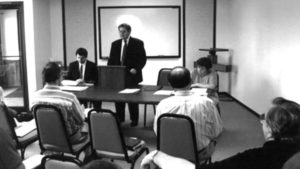 The Right Man for the Job – Dr. Wyndell Jones
The Right Man for the Job – Dr. Wyndell Jones
Dr. O. Wyndell Jones provided leadership through the transition into becoming a state convention. Dr. Jones became the Executive Director-Treasurer in June of 1985. He came to Iowa from a state convention staff position in Alabama. Ed Gregory remembers, “Dr. Jones was called to the Fellowship with the view that he could lead the organization to becoming a Convention. He came with a vision to make that happen and he and his wife Audie really tried hard to become Iowans. He had been a pastor in a number of churches in his home state of Alabama so he understood what it meant to pastor. He also had an understanding of convention life from serving at the Alabama Convention. We didn’t have any experience partnering together as a convention so he brought a lot of the tools we needed, especially financial and strategic planning. He also had essential experience with how to partner with the International Mission Board (IMB) and the North American Mission Board (NAMB) in those days.”
“Dr. Jones provided strong and decisive leadership in a time when we really needed it,” said Pastor Shaull. “He had an authoritative leadership style that helped us get where we needed to go. He also had a lot of connections in other states, such as his home state of Alabama, which was really helpful as we were growing.”
There had always been a strong drive toward cooperation but there was now an increasing desire among all the church leaders to move forward as a state convention. Pastor John remembers the process, “The process involved having to be approved by two state conventions. The discussions were so affirming and uplifting that I can’t remember any disagreement or frustration by anyone involved.”
“One thing we did during Dr. Jones’ tenure was to create partnerships with other states,” said Pastor Mike Carlson, pastor at New Bridge Church in Winterset. “We had partnerships with Missouri, Tennessee, Arkansas, and more. We needed a lot of help then because we had a bold thrust to start new churches. We set really big goals. We were still figuring out the best way to start churches but we were making a difference in terms of evangelism and these partnerships were critical.”
The convention continued to grow slowly, continuing the work that had begun decades earlier. The Lord continued to bring many great pastors and leaders into the state. “We had a close partnership with each other back then because we needed each other to survive,” said Pastor Carlson. “We were small and we knew everybody that was involved. Every time a pastor started their ministry in the state, it was a huge celebration. Especially if they were a native Iowan because they already knew how cold the winters were in this mission field we call Iowa. It’s not the easiest place to start a ministry so we banded together for support.” A decade passed and in 1995, the leaders finally came to a place where they discerned the time had come.
 Our Time Has Come – Becoming a Convention
Our Time Has Come – Becoming a Convention
The decision was made to constitute as a state convention in 1995. Once the decision was made, the process was pretty straightforward. A constitution, bylaws, and articles of incorporation were prepared by a committee and approved by the board of directors. Finally, a formal motion was approved at the 1995 Iowa Southern Baptist Fellowship meeting at First Baptist (New Bridge) in Winterset. This was the same location that the Iowa Southern Baptist Association was constituted. At the conclusion of that meeting, the existing organization was dissolved and a new entity called the Baptist Convention of Iowa (BCI) was born. Representatives from Missouri and the SBC came together to celebrate the milestone of moving forward in this new venture.
“The title of the constituting event was, ‘Our Time Has Come,’ and we felt it captured the spirit of what God had been doing,” said Ed Gregory, who served during the transition as the last president of the Iowa Fellowship and as the first president of BCI. “There was a recognition that the Lord had brought us to this opportunity and that it was a continuation of what He had been doing for decades. The ‘fullness of time’ had come for the work in Iowa and we wanted to embrace and celebrate it. There was a great sense of gratitude, first toward God, then toward Missouri, the other convention partners, and the fellowship of pastors and church leaders. It was a true and happy celebration.”
“It was a huge milestone and growth opportunity,” said Pastor Carlson. “It represented that the work in Iowa was growing and maturing. We were responding to that growth and also planning for further expansion. We were still heavily supported by NAMB but it gave us some recognition that we were ‘grown up’ now. Though we received generous funds from NAMB, we are no longer totally dependent.”
“I remember there was a lot of excitement,” said Pastor Shaull. “We had always been considered part of the Missouri Convention, like an adopted child. We were really looking forward to the opportunity of standing on our own feet. We were grateful for everything that Missouri did for us and we always had a great relationship. They started a lot of churches, especially in the southern part of the state. But we were also eager to launch out on our own.
“Taking that step changed our mindset and created a high level of ownership,” said Pastor Carlson. “It was time to step up and take ownership of the ministry ourselves. This in turn shaped the mindset of the pastors and church leaders in Iowa. We had typically had volunteers come in from other states to run our VBS and building projects. We had to change our mindset to start doing this stuff on our own and taking more ownership for our own ministry needs. There were a lot of amazing ministry opportunities that came as a result of taking ownership.”
Along with the gratitude there was a feeling of hope and optimism. Ed Gregory said, “There was no drastic change immediately after becoming a convention. It was a continual development. But we came out of that meeting with a sense that there was something great in the future. We had a sense that this wasn’t the end but rather that this was just the beginning of a whole new era of what God wanted to do.”
From Mission Field to Mission Agency
It is encouraging to remember that Iowa was once a “mission field” for the Missouri Convention. They were coming up to plant churches and strengthen the churches that were here. “Until we became a convention, we were perceived as a mission project from Missouri,” said Pastor Carlson. “Becoming a convention changed the way we saw ourselves and the way other conventions saw us. We used to be a mission field, now we are a mission agency, we are still on mission in Iowa but we are also a sending group. We were growing up and we were starting to give back.”
In many ways, viewing Iowa as a mission field has not changed. We still see our state as a mission field and we still work together to make disciples, plant new churches, and reach our communities with the gospel of Jesus Christ.

